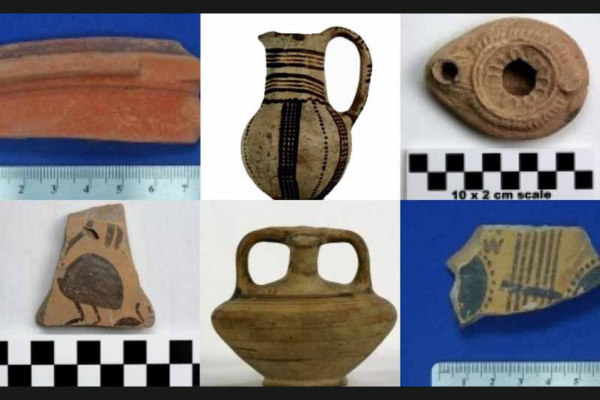On View: Cypriot Ceramics from the Ohio State Museum of Classical Archeology

Curator's Statement:
MOCA was established by Professor Timothy Gregory (History) in 2005 with support from the Office of Research of the University. The collection consolidated objects previously held by the Departments of History, Greek and Latin (now Classics), the Center for Paleographical and Epigraphical Studies, and OSU’s excavation at Isthmia, Greece.
Our museum is currently engaged in three projects. In fall 2024, we will launch a new website, moca.osu.edu, that will contain a searchable online database of our collection. Behind the scenes, MOCA is working to transfer our collection of sherds, lithics, and other small finds into an upgraded storage system. Finally, we are exhibiting select objects from our collection in spaces where they may be accessed by the wider campus community.
How was our collection formed? Unlike other Ohio institutions, Ohio State did not establish a teaching collection in Mediterranean archaeology during the era of the legal antiquities trade. (Although Italy, Egypt, Greece, and Cyprus banned the unlicensed export of antiquities early on, the United States did not have a blanket import ban until 1980). MOCA absorbed a handful of small, pre-existing collections on campus in addition to donations from the Columbus community. Due to serious legal and ethical issues regarding the antiquities trade, we no longer accept donations.
No objects in MOCA’s collection came from a scientific excavation. As such, they tell us very little about ancient Mediterranean societies. Rather, MOCA’s story is the history of collecting: how and why visitors to the Mediterranean decided to pick up distinctive objects and bring them home. Ironically, as artifacts in our collection were ripped from their depositional context, they created new stories that can be accessed via the study of accession records, auction catalogs, and newspaper reports. Provenance research—the study of how objects ended up where they now are—will be a major activity of MOCA’s new iteration.
The objects from ancient Cyprus on display here are among the most evocative in MOCA’s collection. These intact ceramic vessels were acquired between 1867-75 by Luigi Palma di Cesnola (1832-1904). Born on Sardinia, Cesnola would emigrate to the United States to found a military academy shortly before the Civil War. Cesnola served with distinction, winning the Medal of Honor at the 1863 Battle of Aldie, Virginia, surviving a Confederate prisoner of war camp, and reaching the brevetted rank of brigadier general in 1865. Like many war heroes, Cesnola entered the Republican patronage machine after the war. He would serve as American minister on Cyprus between 1865-77.
Cesnola is one of Mediterranean archaeology’s problematic founders. In his decade on Cyprus, Cesnola scoured the island for antiquities, eventually exporting some 35,000 to the United States. Like his rival Heinrich Schliemann (1822-90), Cesnola was a swashbuckler. Cesnola vied for celebrity by staging sensational discoveries of ‘treasures’ in hope of attention from the New York press. Cesnola’s record was mixed as Schliemann’s. Without doubt, Cesnola produced the first methodical inventory of Cypriot archaeological sites. Most of what we now know about ancient Cyprus builds on his research. Unfortunately, Cesnola was a serial fabulist. Even by contemporary standards his excavation practices were atrocious. Members of Cesnola’s team (including his brother Alessandro) would be arrested by British colonial authorities for looting.
Cesnola’s haul of Cypriot antiquities would be purchased by the newly-founded Metropolitan Museum of Art (MMA) in 1879. Cesnola himself would serve as the museum’s director until his death in 1904. Over the following decades, the MMA auctioned off all but 5,000 objects of Cesnola’s collection. Dozens of small museums across the country have collections of ex-Cesnola objects.
Ancient Cyprus is fascinating and enigmatic. During the Early Iron Age (1100-700 BCE), many Greek speakers migrated to Cyprus, bringing with them a script called the Cypriot syllabary. On the island, they mingled with indigenous Cypriots and Phoenician immigrants from the Levant to create a vibrant and unique archaeological culture. The kingdoms of Cyprus had immense riches, trading with Egypt, the neo-Assyrian empire, and the Phoenician world in a critical period of Mediterranean history. But unlike their relatives in Greece, Cypriots recorded little in their script. Few Cypriots actively participated in the canonical events of Greek history in the fifth and fourth centuries BCE. Some of the objects on display here are dated to the Cypro-Archaic Period, roughly 750-500 BCE.
When did Ohio State purchase this collection? This remains uncertain. A century ago, curators of ancient art saw themselves as tastemakers. As more and more Greek sculpture and Attic ceramics arrived in American museums from the 1900s on, curators felt no need to hold onto Cypriot antiquities, which were increasingly perceived as uninspired or even ugly. The MMA deaccessioned most of its Cypriot collection by 1927. Many small collections acquired ex-Cesnola objects cheaply as late as the 1950s. As recently as 2016, the Toledo Museum of Art auctioned off “duplicates” from its Cypriot collection over the objections of the Cypriot government. Once antiquities disappear onto the market, they are rarely seen again.
Today, ancient Cyprus is under-studied at American universities. Only a single expert on ancient Cyprus currently holds a position in a PhD-granting department. By making our ancient Cypriot collection available for public view, we hope to keep teaching and research about the island’s civilizations active on campus.
